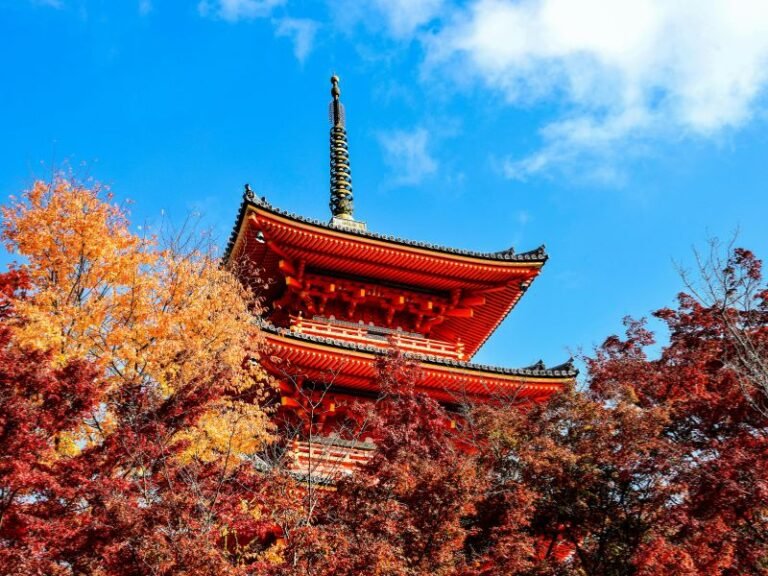The Best Places to Visit in Japan for First Timers (My top picks-Tokyo, Kyoto, Hakone)
If you’re planning your very first trip to Japan — yay! you’re in a beautiful, unforgettable adventure. As someone who’s lived in Japan over 40 years, I know how hard it can be to choose where to go… there are just too many amazing places, right?
So today, I’m sharing my personal top 5 favorite spots in three of the best cities for first-time travelers: Tokyo, Kyoto, and Hakone. Whether you’re a couple, a family with kids, or flying solo, these places are full of history, culture, food, and fun — without being overwhelming!
Top 5 Places to Visit in Tokyo
1. Senso-ji Temple at Asakusa (浅草)

Senso-ji (浅草寺) is Tokyo’s oldest temple, founded in the year 628! As soon as you walk through the grand Kaminarimon Gate, with its massive red lantern, you’ll feel the energy of old Tokyo.
After entering, you’ll stroll along Nakamise-dori, a lively street lined with traditional souvenir shops and yummy street food. Don’t miss the freshly made Ningyo-yaki (sweet sponge cakes filled with red bean paste(あん(An) in Japanese) You may love sweet bean paste)!
At the end of the street, you’ll find the main temple building, where visitors come to pray, draw Omikuji (fortune slips), and light incense for blessings.
My Local Tip : Even if it’s busy, take a moment off to the side, watch the smoke rise from the incense burner, and listen to the chanting inside. It’s peaceful and beautiful.
How to get there
5 min walk from Asakusa-Station. Once you exit the station, just follow the signs — or the crowd!
2. Shibuya Crossing at Shibuya (渋谷)
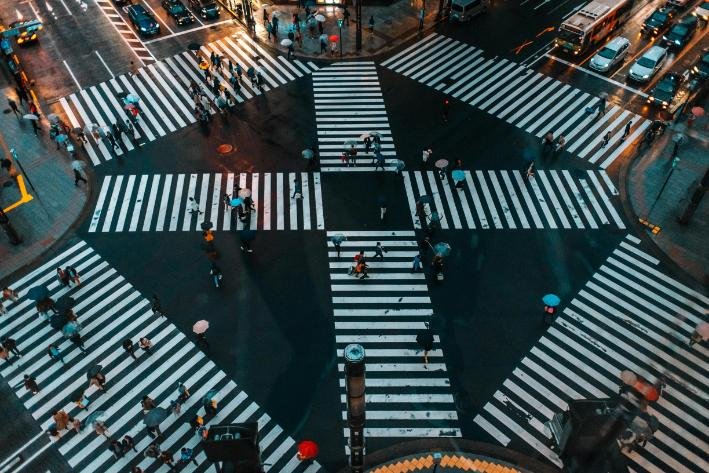
The world’s busiest crossing and a hub of culture. At peak times, up to 3,000 people cross from all directions. It’s a mesmerizing sight of organized chaos, often referred to as a “scramble” crossing. For a bird’s-eye view, head to the second floor of the Starbucks across from Shibuya Station. It’s one of the busiest Starbucks locations globally and offers a perfect vantage point.
How to Get There
Just in front of Shibuya Station.
3. Takeshita Street at Harajuku (原宿)

If you’re interested in Tokyo’s trendiest, most colorful, and youth-filled area, Takeshita Street (竹下通り) in Harajuku is where you need to go! Just one minute from Harajuku Station, this narrow, buzzing street is a must-see. You can enjoy Japanese pop and Kawaii (かわいい)culture.
How to Get There
You need a couple of minutes walk from Harajuku-Station and Meiji-Jingumae Station.
- JR Harajuku Station(原宿駅) (Yamanote Line): Takeshita Exit is right at the entrance of the street.
- Tokyo Metro Meiji-Jingumae Station (明治神宮前駅)(Chiyoda & Fukutoshin Lines): Use Exit 5, and walk just a couple of minutes.
4. TeamLab PlanetsImmersive digital art experience
If you’re looking for something unique during your trip to Tokyo, don’t miss teamLab Planets — an unforgettable immersive digital art experience. Even better, it’s located close to Odaiba, where you can see the full-size Gundam statue.
Step Into Another World at TeamLab Planets
At teamLab Planets, you don’t just look at art — you become part of it.
You’ll walk barefoot through water, mirrors, and floating flowers in massive, interactive spaces. Each room is a different universe. Some feel calming and dreamlike, while others are surreal and make you feel like you’re floating in space.
Highlights include:
- The Infinite Crystal Universe – Walk among endless sparkling lights
- Floating Flower Garden – Surrounded by real orchids that move as you do
- Waterfall Room – Walk through shallow pools with projected fish that react to your steps
What to Wear: Since you walk through water, shorts or skirts are best. You’ll need to remove your shoes and socks!
How to Get There
From Shinjuku Station to teamLab Planets:
- Take the JR Yamanote Line to Shimbashi Station
- Transfer to the Yurikamome Line → Get off at Shin-Toyosu Station
- 1-minute walk to teamLab Planets
Bonus: Visit the Life-Size Gundam in Odaiba
Location: DiverCity Tokyo Plaza (Odaiba)
Closest Station: Daiba Station or Tokyo Teleport Station
After exploring teamLab Planets, head over to Odaiba, just a short train or taxi ride away. There you’ll find the impressive Gundam Statue — a full-size, 18-meter tall robot from the anime series.
How to Get There
From teamLab Planets to Odaiba: Take the Yurikamome Line from Shin-Toyosu → Get off at Daiba Station (台場駅)(about 10–15 mins)
5. Tsukiji Outer Market

Tsukiji was once the world’s largest fish market, it was famous for the early-morning tuna auctions. Now the market are moved to the Toyosu area, and Tsuna auctions are held there. But still we can enjoy the Tsukiji Outer Market (築地場外市場) and taste a wide variety of food, like super fresh Sushi , Sashimi (raw fish), Grilled seafood sticks, etc..you might love them.
Go early in the morning (between 8 AM–11 AM) when it’s most lively — and when the freshest food is served. Many shops close after lunch, so don’t wait too long! You can also try a sushi breakfast — trust me, it’s a thing in Japan, and it’s amazing
How to Get There
Nearest Station:
- Tsukiji Station (Tokyo Metro Hibiya Line) – 1–2 minute walk
- Shintomicho (新富町)Station (Tokyo Metro Yurakucho Line) – 5-minute walk
- Higashi-Ginza Station (Toei Asakusa Line) – 5-minute walk
Top 5 Places to Visit in Kyoto
Kyoto is the heart of traditional Japan. Think temples, kimono, and quiet beauty. These are my top picks for a cultural experience:
1. Kiyomizu-dera Temple (清水寺)

Nestled in the heart of Kyoto, Kiyomizu-dera is a must-visit destination for travelers seeking a blend of history, culture, and breathtaking views. This UNESCO World Heritage Site is one of Japan’s most celebrated temples. Please note that there are always so many visitors. Need some time to see this temple.
A Brief History of Kiyomizu-dera
Founded in 778 AD, Kiyomizu-dera, or the “Pure Water Temple,” is named after the Otowa Waterfall, whose pure streams run through the temple grounds. The current structure dates back to 1633, as the original buildings were lost to fires over the centuries. Despite its age, the temple remains a symbol of resilience and spiritual significance.
Highlights of Kiyomizu-dera
The Wooden Stage
The temple’s most famous feature is its wooden stage, which juts out 13 meters above the hillside. Constructed without the use of nails, this architectural marvel offers stunning views of Kyoto, especially during the cherry blossom and autumn foliage seasons.
Otowa Waterfall (音羽の滝)
Visitors can drink from the three streams of the Otowa Waterfall, each said to grant a different blessing: longevity, academic success, or a prosperous love life. Choose wisely—drinking from all three is considered greedy!
Jishu Shrine
Located within the temple grounds, Jishu Shrine is dedicated to the deity of love and matchmaking. Test your romantic fate by walking between two stones with your eyes closed—success means true love is in your future!
How to Get There
From Kyoto Station, take the Kyoto City Bus (No. 100 or 206) to Gojo-zaka or Kiyomizu-michi bus stop. From there, it’s a 10-minute uphill walk to the temple. Wear comfortable shoes, as the path can be steep!
2. Arashiyama Bamboo Grove
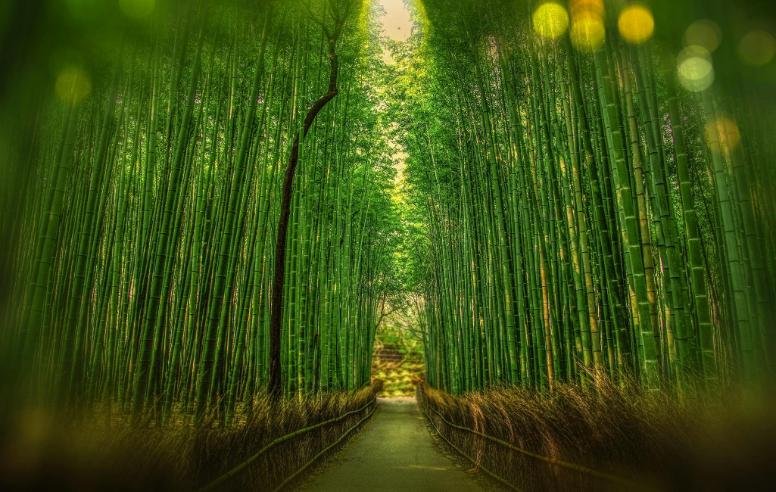
The bamboo grove stretches about 400 meters, creating a tunnel-like walkway. The tall bamboo sways gently in the wind, casting soft light and shadows that make the atmosphere truly magical. You may feel like in a dream. Like other place in Kyoto, many visitors come here. If you want to enjoy this place quietly, I strongly recommend that you go here early in the morning.
How to Get There
From Kyoto Station:
- By Train: Take the JR Sagano Line to Saga-Arashiyama Station. It’s a 15-minute ride, followed by a 10-minute walk.
- By Bus: Take Kyoto City Bus No. 28 to Arashiyama-Tenryuji-mae. The ride takes about 30 minutes.
3. Fushimi Inari Taisha
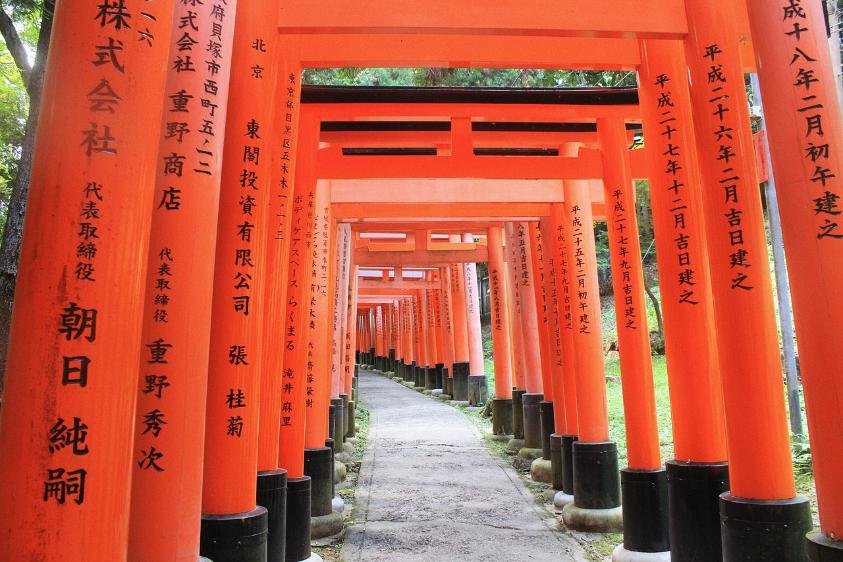
Fushimi Inari Shrine, located in Kyoto, is one of Japan’s most iconic landmarks. Known for its seemingly endless path of vibrant red torii gates, this shrine offers a unique blend of cultural significance and natural beauty. Whether you’re a history enthusiast, a photography lover, or simply looking for a memorable experience, Fushimi Inari Shrine is a must-visit destination.
When I first visited Fushimi Inari Shrine, I thought it was simply a temple with many torii gates. However, I quickly realized it was actually a hiking course! I walked through the torii gates, expecting to reach the goal soon, but it felt like the path went on forever. It took over one hour (half way..we needed another one hour to return.) While the hike was tiring, it was also a great way to enjoy the serene surroundings and get some exercise. If you’re not planning to go all the way to the top of the mountain, I recommend turning back midway to save time and energy.
A Brief History of Fushimi Inari Shrine
Founded in 711 AD, Fushimi Inari Shrine is dedicated to Inari, the Shinto deity of rice, agriculture, and prosperity. The shrine is the head of over 30,000 Inari shrines across Japan. The thousands of torii gates, donated by individuals and businesses, symbolize gratitude and prayers for success.
The Torii Gate Pathway
The most famous feature of Fushimi Inari Shrine is its pathway of over 10,000 torii gates, which winds its way up Mount Inari. The vibrant red gates create a magical tunnel-like effect, making it a favorite spot for photographers and travelers alike. Please note that there are many people in the Torii road… You need to go early if you want to avoid it.
How to Get There
From Kyoto Station:
- By Train: Take the JR Nara Line to Inari Station. The shrine is a short walk from the station.
- By Bus: Take Kyoto City Bus No. 5 to Fushimi Inari Taisha-mae.
4. Gion District

Gion (祇園) is a historic entertainment district located between Yasaka Shrine and the Kamo River. It’s been around since the Middle Ages and was originally developed to serve travelers visiting the shrine. There are so many interesting place, culture building in this area…so I can’t show everything. If you’re dreaming of seeing old Japan — lantern-lit streets, wooden teahouses, and maybe even a real-life geisha — then Gion is the place to go.
What You Can Do in Gion
- Walk along Hanamikoji Street This iconic street is lined with beautifully preserved buildings and traditional lanterns. You might even see a maiko (apprentice geisha) hurrying to her evening appointment — just remember to be respectful and avoid blocking their path or taking photos too closely.
- Visit Yasaka Shrine At the edge of Gion, this colorful shrine is lively day and night and often decorated with lanterns.
- Enjoy Traditional Tea Houses and try Kyoto-style kaiseki(懐石料理) cuisine or enjoy a simple green tea with Wagashi (和菓子:Japanese sweets) in one of the quiet cafes or tea houses.
- Watch a Cultural Show at Gion Corner. This small theater offers tourists a chance to see a sampling of traditional arts like tea ceremony, ikebana (flower arranging), Noh(能) theater, and even a short geisha dance performance — all in under an hour!
How to Get to Gion
- From Kyoto Station: Take city bus #100 or #206 → Get off at Gion bus stop (The bus ride takes about 20–30 minutes depending on traffic)
- By Train:
- Take the Keihan Line to Gion-Shijo Station
- Or take the Hankyu Line to Kawaramachi Station and walk a few minutes
5. Nishiki Market
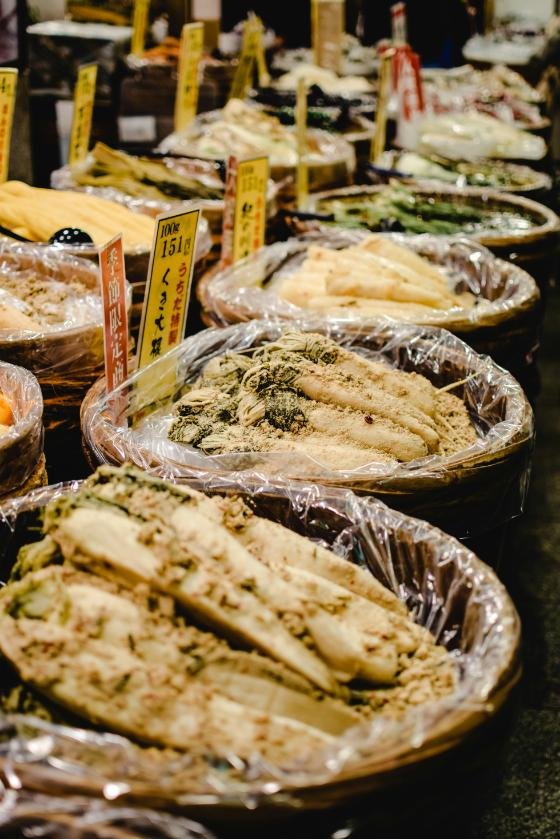
Nishiki Market is more than just a shopping street — it’s a living piece of Kyoto’s food culture that’s been around for over 400 years. Many of the stalls are family-owned businesses that have been passed down through generations.
You will find street snacks like skewered tempura (Kushikatsu (串カツ)Yuba (湯葉) (tofu skin), and soy donuts, fresh sashimi, grilled seafood, Japanese tsukemono (漬物-pickles). Of cause, you can find matcha sweets!
When you are looking around, please try a few local food. Many shops offer free samples or sell small amount.
How to Get There
From Kyoto Station:
- Take the Karasuma Subway Line to Shijo Station
- Walk 5 minutes to the entrance near Teramachi Street or
- Take a bus to Shijo-Kawaramachi and walk a few minutes
Top 5 Places to Visit in Hakone
Hakone is the perfect place to relax in nature, enjoy hot springs, and (fingers crossed) catch a view of Mt. Fuji!
1. Lake Ashi Cruise (芦ノ湖遊覧船)
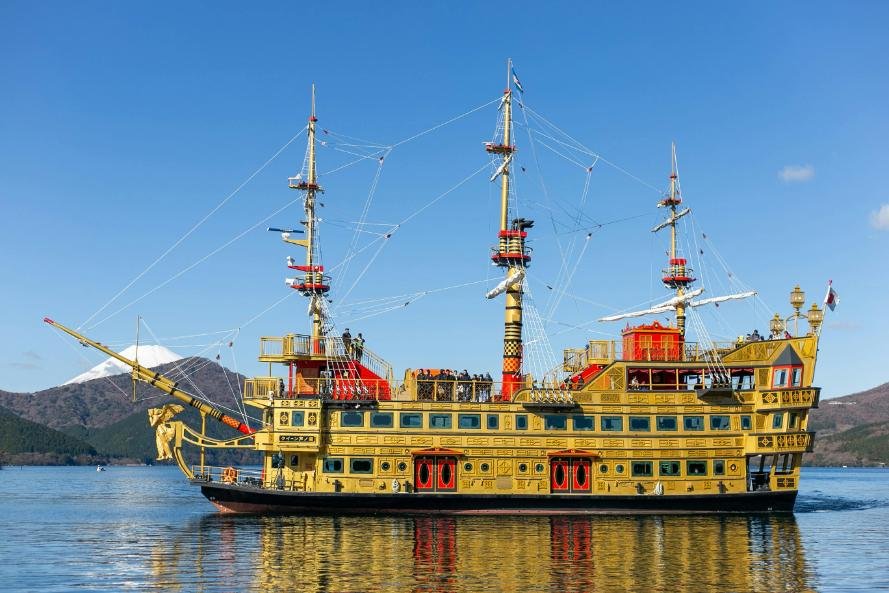
Lake Ashi (also called Ashinoko(芦ノ湖)) is a crater lake formed from a volcanic eruption over 3,000 years ago. It’s located in the heart of the Hakone area and is famous for its calm waters, stunning views, and the beautiful red Torii gate of Hakone Shrine that stands along the lake’s edge.
There are two main companies operating cruises on Lake Ashi, but the most popular is the Hakone Sightseeing Cruise, which features fun, colorful pirate ships that look straight out of a fantasy movie.
Cruise Details:
- Duration: About 25–40 minutes (depending on the route)
- Stops: Togendai ⇄ Hakone-machi ⇄ Moto-Hakone
- Views: On a clear day, you can see Mt. Fuji in the distance, reflected in the lake — it’s absolutely breathtaking!
The ships have both open decks and indoor seating, so you can enjoy the view in any weather.
The best chance to see Mt. Fuji is during the winter months (Dec–Feb) when the air is clear. In summer, clouds often block the view, so manage your expectations and enjoy the peaceful scenery either way.
Also, try to sit on the left side of the boat if you’re traveling from Togendai toward Moto-Hakone — that’s the side Mt. Fuji appears on!
How to Get to the Cruise
From Shinjuku Station (Tokyo):
- Take the Odakyu Romance car to Hakone-Yumoto Station (箱根湯本駅)
- Transfer to the Hakone Tozan Railway(箱根登山鉄道) → Get off at Gora (強羅駅)
- Take the Hakone Ropeway from Sounzan(早雲山駅) to Togendai Station(桃源台駅)
- The cruise departs right from Togendai Pier
Hakone Freepass is a great deal if you plan to take the ropeway, cruise, and other local transport.
2. Owakudani Volcanic Valley (大涌谷)
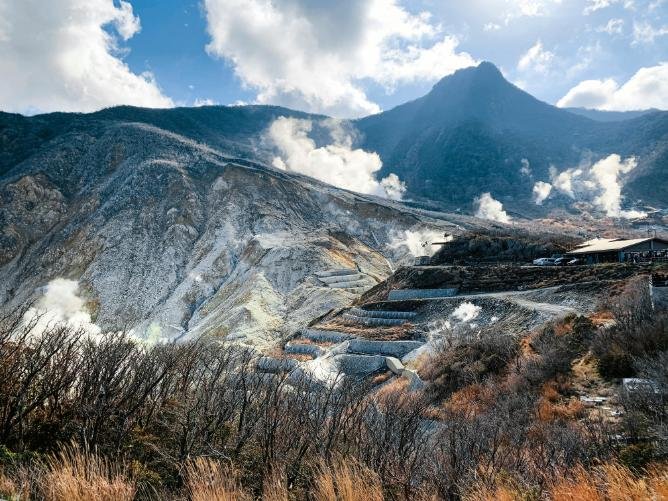
Owakudani literally means “Great Boiling Valley”, and that’s exactly what it feels like. Formed about 3,000 years ago by a volcanic eruption of Mount Hakone, this area is still geothermally active — you’ll see steam vents, sulfurous clouds, and hot rivers all around.
It’s one of the few places in Japan where you can see the earth breathe. The smell of sulfur can be strong here, so if you’re sensitive, bring a mask or handkerchief. Also, wear comfy shoes — it’s a volcanic area with uneven paths.
Top Things to Do at Owakudani
- Take in the Views On a clear day, you’ll get a spectacular view of Mt. Fuji right from the valley — especially from the Hakone Ropeway, which passes over the steaming landscape. I will show you the details later but I strongly recommend to ride Hakone Ropeway. My parents really liked the fantastic view from the Ropeway.
- Try the famous Black Eggs (Kuro-Tamago(黒玉子). These eggs are boiled in Owakudani’s natural hot springs and turn black from the sulfur in the water. Local legend says eating one will add 7 years to your life! (But don’t eat more than two, just in case.)
- Walk Around the Steam Vents. A short walking path near the upper area where you can get close to the vents (access may vary depending on volcanic activity).
- Shop and Snack The Owakudani rest house has shops with local sweets, hot snacks, and souvenirs related to Mt. Fuji and the black eggs.
How to Get to Owakudani
It’s all part of the scenic Hakone Loop, and the Hakone Free pass covers the entire journey!
3. Hakone Open-Air Museum(彫刻の森美術館)
Unlike most art museums, this one is entirely outdoors, spread across a spacious park surrounded by the mountains of Hakone. Sculptures are placed throughout the gardens, blending perfectly with the natural scenery. It’s peaceful, refreshing, and fun to explore.
There are also indoor galleries, kid-friendly areas, and even a hot spring foot bath! You can relax seeing the beautiful Hakone mountains.
Top Highlights of the Hakone Open-Air Museum
- Picasso Pavilion : A fascinating indoor gallery featuring over 300 works by Pablo Picasso, including ceramics, paintings, and sketches. It’s a great contrast to the outdoor sculptures.
- The Symphonic Sculpture : A colorful tower you can climb from the inside! It’s made of stained glass and gives you a panoramic view of the mountains — great for photos.
- Sculptures in Nature : Over 120 sculptures by both Japanese and international artists are scattered throughout the park. Some are abstract, some are lifelike, and some you can even touch or walk inside!
- Kid-Friendly Art Playgrounds : There’s a huge net structure and other fun interactive art pieces where kids can play safely.
- Foot Bath Area : After walking around the museum, soak your feet in a natural hot spring foot bath while enjoying the view. It’s free with admission!
How to Get There
From Hakone-Yumoto Station:
- Take the Hakone Tozan Railway to Chokoku-no-Mori Station (彫刻の森駅)
- The museum is just a 2-minute walk from the station
If you have a Hakone Freepass, this journey is covered!
4. Hakone Ropeway

The Hakone Ropeway is part of the popular Hakone Loop, connecting Sounzan Station to Togendai Station (at Lake Ashi) with a stop at Owakudani, the famous volcanic valley. The entire ride is about 25 minutes, and the cable cars run continuously.
Each gondola seats about 10 people, and the large windows give you fantastic views throughout the ride.
What You’ll See on the Way
- From Sounzan to Owakudani: Ride high above green valleys and forests. As you approach Owakudani, the landscape changes dramatically — you’ll see steaming volcanic vents and yellow sulfur fields below. It feels like you’re floating over another planet!
- From Owakudani to Togendai (Lake Ashi): On a clear day, this is where you’ll see the iconic Mt. Fuji standing tall beyond the lake. The view is incredible, especially in the winter months, when Fuji’s peak is clearly visible.
How to Ride the Hakone Ropeway
From Tokyo (Shinjuku):
- Take the Odakyu Romancecar to Hakone-Yumoto
- Transfer to the Hakone Tozan Railway and go to Gora Station
- Take the cable car to Sounzan Station
- Board the Hakone Ropeway at Sounzan
The Hakone Freepass covers all of these routes, making it an easy and budget-friendly choice for travelers!
5. Hakone Onsen (Hot Spring Bath)
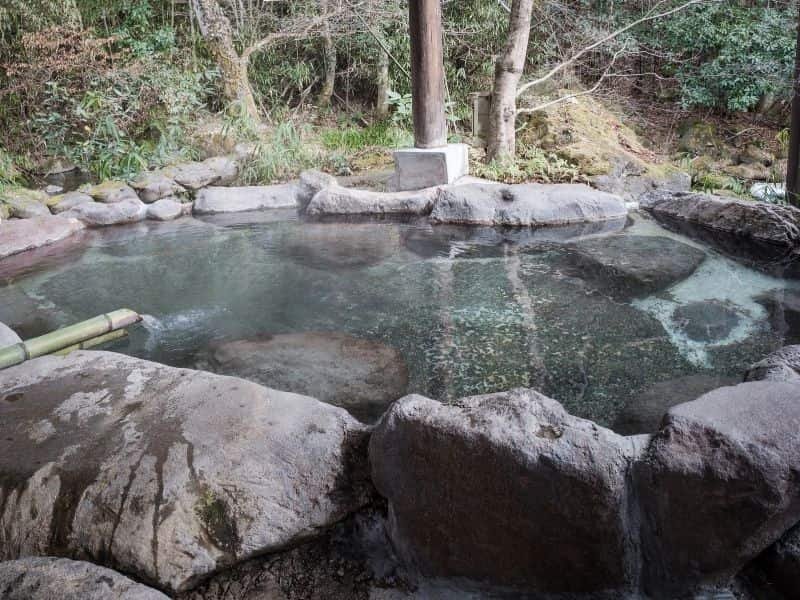
You must try a Japanese onsen! Many ryokan (Japanese style inn) offer fantastic hot spring bath.
For families, Yunessun is a fantastic choice. It’s an onsen theme park with unique and playful baths, like coffee, wine, and green tea, which make it especially fun for kids and adults who enjoy something a little unconventional. It’s a place where families can bond and enjoy the hot spring experience in a relaxed and casual setting.
For older visitors—or anyone seeking a more traditional and peaceful retreat—the Hakone Shichiyu (箱根七湯) (Seven Hot Springs) is an excellent option. These historic hot springs include Yumoto Onsen, the oldest and most famous hot spring in Hakone; Tonosawa Onsen(塔之沢温泉)a tranquil forest escape; and Miyanoshita(宮ノ下温泉) Onsen, renowned for its skin-enhancing waters and historic inns like Fujiya Hotel (富士屋ホテル).
Speaking of Yumoto Fujiya Hotel, it is a true gem in Hakone’s history. Established in 1878, it is one of Japan’s oldest Western-style hotels and has hosted notable figures like Charlie Chaplin and Helen Keller. The hotel is a blend of classic Meiji-era architecture and modern luxury, with several of its buildings registered as tangible cultural properties. Guests can enjoy the Miyanoshita Onsen waters in the hotel’s baths, dine at its elegant French and Japanese restaurants, and explore its beautiful gardens and museum. Staying at Fujiya Hotel is not just accommodation—it’s an experience steeped in history and charm.
Other gems include:
- Ashinoyu Onsen (芦之湯温泉): This tranquil hot spring is known for its sulfur-rich waters, which are said to have powerful healing properties. Its serene location near Lake Ashi makes it ideal for relaxation.
- Sokokura Onsen:(底倉温泉) Tucked away in a quiet, mountainous area, this onsen provides an intimate and secluded bathing experience, surrounded by nature.
- Dogashima Onsen:(堂ヶ島温泉) A hidden gem with picturesque landscapes, it offers a peaceful escape from the more crowded hot springs in Hakone.
How to Get to Hakone from Tokyo (Shinjuku)
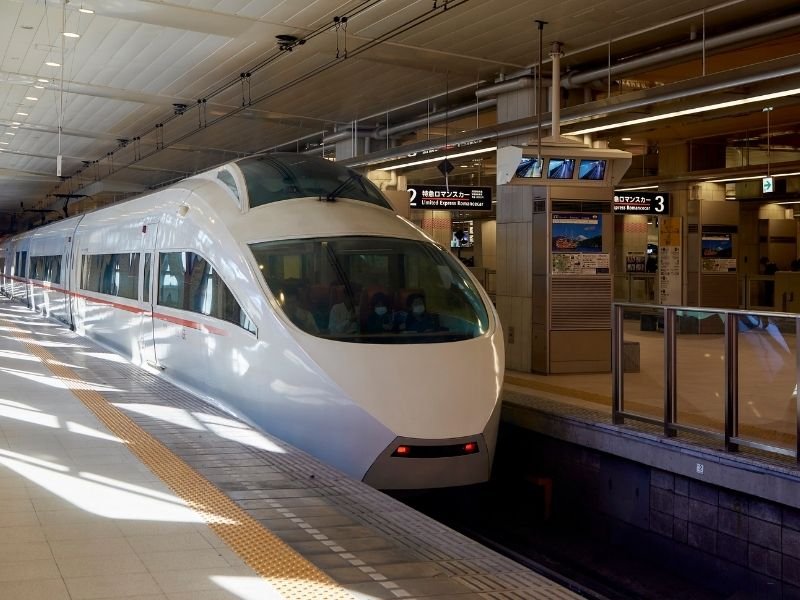
One of the easiest and most scenic ways to get from Tokyo to Hakone is by riding the Odakyu Romance car — a stylish, comfortable limited express train that takes you straight from Shinjuku Station to Hakone-Yumoto Station in about 85 minutes.
Enjoy traveling in Japan! またね〜!(See you soon!)

